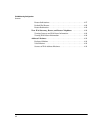
3-23
IPv6 Addressing
Multicast Application to IPv6 Addressing
■ multicast scope: Bits 13-16 set boundaries on multicast traffic distribu-
tion, such as the interface defined by the link-local unicast address of an
area, or the network boundaries of an organization. Because IPv6 uses
multicast technology in place of the broadcast technology used in IPv4,
the multicast scope field also controls the boundaries for broadcast-type
traffic sent in multicast packets.
For example, the following prefix indicates multicast traffic with a tempo-
rary multicast address and a link-local scope:
ff12 or (binary) 1111 1111 0001 0010
■ group identifier: This field includes the last 112 bits of the multicast
address and contains the actual multicast group identity. (Refer to RFCs
3306, 4291, and 2375.)
Solicited-Node Multicast Address Format
The solicited-node multicast address the switch generates for a configured
unicast or anycast address is composed of a unique, 104-bit multicast prefix
(ff02:0:0:0:0:1:ff) and the last 24 bits of the subject address. For example, if a
VLAN interface is configured with a link-local address of
Bit Use
0 reserved
1 interface-local (loopback)
2 link-local (same topology as the corresponding link-local unicast scope)
3 reserved
4 admin-local (smallest administratively configured scope)
5 site-local (single site)
6 unassigned
7 unassigned
8 organization-local (multiple sites within the same organization)
9 unassigned
A unassigned
B unassigned
C unassigned
D unassigned
E global
F reserved


















